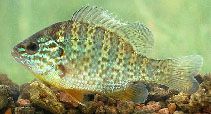http://www.fishbase.org/Summary/speciesSummary.php?genusname=Lepomis&speciesname=gibbosus ---> http://52.67.158.155/Summary/speciesSummary.php?genusname=Lepomis&speciesname=gibbosus
http://52.67.158.155/Summary/speciesSummary.php?genusname=Lepomis&speciesname=gibbosus ---> https://fishbase.net.br/Summary/speciesSummary.php?genusname=Lepomis&speciesname=gibbosus
https://fishbase.net.br/Summary/speciesSummary.php?genusname=Lepomis&speciesname=gibbosus ---> https://fishbase.net.br/summary/Lepomis-gibbosus.html
Lepomis gibbosus, Pumpkinseed : fisheries, gamefish, aquarium

You can
sponsor
this page
Common name (e.g. trout)
Genus + Species (e.g. Gadus morhua)
-

-
About this page
-
Languages
-
User feedbacks
-
Citation
-
Uploads
-
Related species
-


 Pumpkinseed
Upload your
photos
and
videos
Pumpkinseed
Upload your
photos
and
videos
Pictures
|
Stamps, Coins Misc.
|
Google image
 Lepomis gibbosus
Lepomis gibbosus
Picture by
Kohout, J.
Teleostei (teleosts) >
Centrarchiformes
(Basses) >
Centrarchidae
(Sunfishes)
Etymology:
Lepomis:
Greek, lepis = scaled + Greek, poma = gill cover, operculum (Ref.
45335, 79012
)
;
gibbosus:
gibbosus
from gibbous, or like a full moon, referring to body shape (Ref.
1998
)
.
More on author:
Linnaeus
.
Environment: milieu / climate zone / depth range / distribution range
Ecology
Freshwater; brackish; benthopelagic; pH range: 7.0 - 7.5; dH range: 10 - 15; potamodromous (Ref.
51243
); depth range 0 - 41 m (Ref.
1998
). Subtropical; 4°C - 30°C (Ref.
1672
); 50°N - 32°N, 125°W - 64°W (Ref.
86798
)
North America: New Brunswick in Canada south to Savannah River in Georgia, USA; Great Lakes, Hudson Bay (Red River), and upper Mississippi River basins from Quebec west to southeastern Manitoba and North Dakota, and south to north Kentucky and Missouri, USA. Introduced to Pacific drainages from British Columbia to California. Several countries report adverse ecological impact after introduction.
Length at first maturity / Size / Weight / Age
Maturity: L
m
?
range ? - ? cm
Max length : 40.0 cm TL male/unsexed; (Ref.
86798
); common length : 9.9 cm TL male/unsexed; (Ref.
12193
); max. published weight: 630.00 g (Ref.
4699
); max. reported age: 12 years (Ref.
72493
)
Dorsal
spines
(total): 10 - 12;
Dorsal
soft rays
(total): 10-12;
Anal
spines
: 3;
Anal
soft rays
: 8 - 11;
Vertebrae
: 28 - 30
Inhabits vegetated lakes and ponds, as well as quiet pools of creeks and small rivers (Ref.
86798
). Feeds on small fishes and other vertebrates (Ref.
1998
), as well as fish eggs (Ref.
2058
). Adtults rarely form schools but occur in pairs or loose aggregations of three to four individuals; young individuals aggregate in fairly large schools (Ref.
120693
). An introduced species in Europe which avoids swift waters and occurs in estuaries with a salinity up to 18.2 ppt (Ref.
59043
). Reported in Europe to prey on a wide variety of invertebrates (Ref.
59043
). Considered undesirable catch (Ref.
30578
).
Males build the nest on very shallow waters near the shore. The pair then swims in a circular path over the nest and eggs and sperm is released in intervals. The male guards the eggs for about 7 days (Ref.
93240
) and the young (to about 11 days after hatching), then prepares the nest for another spawning with the same or different females (Ref.
1998
). In European waters, each male may spawn with several females in one nest and guard the nest until abandoned by larvae (Ref.
59043
). Produces up to 1000 eggs (Ref.
1672
).
Page, L.M. and B.M. Burr
, 2011. A field guide to freshwater fishes of North America north of Mexico. Boston : Houghton Mifflin Harcourt, 663p. (Ref.
86798
)
IUCN Red List Status (Ref.
130435
)
Least Concern (LC)
; Date assessed:
01 March 2012
CITES
Not Evaluated
Not Evaluated
Threat to humans
Potential pest
Human uses
Fisheries: subsistence fisheries; gamefish: yes; aquarium: commercial
FAO - Publication:
search
|
FishSource
|
More information
Countries
FAO areas
Ecosystems
Occurrences
Introductions
Stocks
Ecology
Diet
Food items
Food consumption
Ration
Common names
Synonyms
Metabolism
Predators
Ecotoxicology
Reproduction
Maturity
Spawning
Spawning aggregation
Fecundity
Eggs
Egg development
Age/Size
Growth
Length-weight
Length-length
Length-frequencies
Morphometrics
Morphology
Larvae
Larval dynamics
Recruitment
Abundance
BRUVS
References
Aquaculture
Aquaculture profile
Strains
Genetics
Electrophoreses
Heritability
Diseases
Processing
Nutrients
Mass conversion
Collaborators
Pictures
Stamps, Coins Misc.
Sounds
Ciguatera
Speed
Swim. type
Gill area
Otoliths
Brains
Vision
Tools
Bio-Quiz
|
E-book
|
Field guide
|
Identification keys
|
Length-frequency wizard
|
Life-history tool
|
Point map
|
Classification Tree
|
Catch-MSY
|
Special reports
Check for Aquarium maintenance
|
Check for Species Fact Sheets
|
Check for Aquaculture Fact Sheets
Download XML
Summary page
|
Point data
|
Common names
|
Photos
Internet sources
AFORO (otoliths)
|
Alien/Invasive Species database
|
Aquatic Commons
|
BHL
|
Cloffa
|
BOLDSystems
|
Websites from users
|
Check FishWatcher
|
CISTI
|
Catalog of Fishes
:
genus
,
species
|
DiscoverLife
|
DORIS
|
ECOTOX
| FAO - Publication:
search
|
Faunafri
|
Fishipedia
|
Fishtrace
| GenBank:
genome
,
nucleotide
|
GloBI
|
Google Books
|
Google Scholar
|
Google
|
IGFA World Record
|
MitoFish
|
National databases
|
Otolith Atlas of Taiwan Fishes
|
Public aquariums
|
PubMed
| Reef Life Survey | Socotra Atlas |
Tree of Life
| Wikipedia:
Go
,
Search
| World Records Freshwater Fishing |
Zoological Record
Estimates based on models
Phylogenetic diversity index (Ref.
82804
): PD
50
= 0.5001 [Uniqueness, from 0.5 = low to 2.0 = high].
Bayesian length-weight: a=0.01148 (0.00913 - 0.01443), b=3.11 (3.06 - 3.16), in cm total length, based on LWR estimates for this species (Ref.
93245
).
Trophic level (Ref.
69278
): 3.3 ±0.1 se; based on diet studies.
Resilience (Ref.
120179
): Medium, minimum population doubling time 1.4 - 4.4 years (tm=2; Fec=600-5000).
Fishing Vulnerability (Ref.
59153
): Moderate to high vulnerability (49 of 100).
Price category (Ref.
80766
):
Unknown
.
Back to Search
Random Species
Back to Top
Accessed through:
Not available
FishBase mirror site :
Laguna, Philippines
Page last modified by :
mrius-barile
|